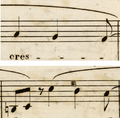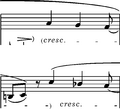



Verbal indications
|
b. 69-71
|
composition: Op. 49, Fantaisie in F minor
..
The crescendo starting earlier in FE (→EE) could be explained by, e.g. Chopin's correction in [FC] or by both variants having been added independently to A and to the copy (or at the stage of proofreading FE1). In later appearances of this phrase (bars 156-158 and 236-238) in all sources crescendo begins earlier than here (as marked by Chopin in A). Due to this fact, in the main text we suggest a variant solution, including the FE version, with a possibility of crescendo beginning later (as in A). category imprint: Differences between sources; Editorial revisions issues: Authentic corrections of FE |
||||||||
|
b. 101
|
composition: Op. 49, Fantaisie in F minor
..
The fact that in FE (→EE) the crescendo begins slightly later could be of an accidental nature or could mean that Chopin added the indication twice – once in A and once in [FC] or while proofreading FE1. category imprint: Differences between sources |
||||||||
|
b. 109
|
composition: Op. 49, Fantaisie in F minor
..
According to us, the fact that the category imprint: Differences between sources issues: Inaccuracies in FE , Centrally placed marks |
||||||||
|
b. 153
|
composition: Op. 49, Fantaisie in F minor
..
category imprint: Differences between sources; Corrections & alterations |
||||||||
|
b. 156-157
|
composition: Op. 49, Fantaisie in F minor
..
In A the category imprint: Graphic ambiguousness; Differences between sources issues: Scope of dynamic hairpins , Inaccuracies in A |




 at beginning of bar in
at beginning of bar in  , Op. 10 No. 5,
, Op. 10 No. 5, 
 & cresc. - - in
& cresc. - - in 